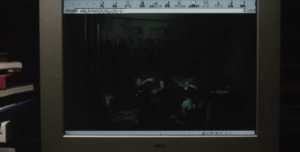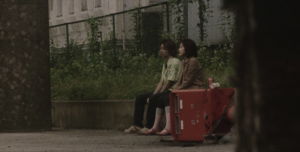Horror as a Vehicle: The Terror of Technology in Kiyoshi Kurosawa’s Pulse
Jack Ashby

A ghostly figure lurks behind pixelated shadows on Kawashima’s computer monitor display
Although horror films have taken various forms throughout cinema history, few have been as introspective, self-reflexive, and ultimately impactful on the viewer as Japanese Horror (J-horror). Kiyoshi Kurosawa’s Pulse (2001) is a prime example, offering a striking commentary on the role of technology in the modern world while paying homage to both J-horror and Japan’s complex history. In Pulse, Kurosawa’s art-cinema influences are evident as carefully constructed scenes work to build a sense of dread as an unknown force begins to collect itself throughout the film. The film combines masterful editing, dread-inducing sound, and camera work that seemingly gives the camera a mind of its own, not only to create visceral horror but to comment on the loneliness and isolation caused by technology in the modern world. By intertwining technology and the ghostly or supernatural, Pulse reimagines the threat of technology as an unknowable, uncontrollable evil that has afflicted post-war Japan.
Throughout the film, Kurosawa employs a strangely unmotivated, detached style of camera movement that, when used in conjunction with the images in the frame, hints at an unknown force at work both in the world of the film and in the world of the viewer. This phenomenon and sense of implication are perhaps most prevalent in a scene in which Ryosuke Kawashima (Haruhiko Kato), the protagonist, has a supernatural experience with his computer. In a seemingly out-of-place sequence, we see two short shots of Kawashima in an arcade crowded with screens and people; we then get another brief shot of him walking home, looking unenthused and distant. There is a rapid cut in which we briefly view Kawashima on the phone, potentially with his friend Harue (Koyuki), again looking disinterested. Kawashima is slowly removed from the frame through a series of deframings, and his computer screen briefly comes into focus before again being lost to the shallow focus of the scene. While a seemingly normal camera movement, the diegetic sound of Kawashima’s redialing and his re-entrance into the scene after the camera stops to hover on the computer provides an unnerving sense of autonomy on the part of the camera. This premature, unmotivated movement leaves the viewer with just a moment between themselves and the computer to contemplate the purpose of this focus on the blank screen, all while the faint whirring of a computer remains barely audible in Kawashima’s dimly lit apartment. Through camera movement, Kurosawa pans away from one of the few characters looking to make a human connection in a way that slowly removes the character via deframing and brings the (shallow) focus back onto a technology that appears to have a mind of its own.
While the slow pan, deframing, and unsteady hover of the camera give some inkling of technological autonomy, Kurosawa’s subsequent formal decisions drive home a terrifying sense of connection between the camera and the digital world of the film. After Kawashima enters the frame in focus, he stands up to grab a glass of water, and the focus becomes deeper as he moves away from the camera; however, as he moves closer, his body remains unfocused, and his head and face disappear from the frame. At the same time, his computer appears turned on and seen in focus as the once faint dial-up sounds grow louder in the background. Despite the diegetic background noise of Kawashima pouring himself a glass of water, the camera slowly pans up, bringing the computer further into focus as it begins to display a supernatural image. As Kawashima notices and rushes to the computer, the camera remains detached as he ponders what to do. The first cut of the entire scene comes only when he begins to interact with the computer, bringing the cursed image to the full screen as though the viewer is watching the screen itself, another indication of Kurosawa endowing the film with an autonomous aspect while implicating the viewer in its horror. By compounding the computer screen and the camera, this scene “threaten(s) the coherence of the diegetic (analog) film world by aggressively confronting the spectator,” as Kit Huges states in her analysis (29). There is a distinct lack of focus on the only human character in the scene as the camera and the film itself seem to gravitate toward the screen in the world of the film, thereby confronting the viewer both perceptually and subconsciously by creating visceral terror and subverting viewing expectations. While the ambient droning of analog sounds, dark mise-en-scène, and visuals on the computer stir up visceral dread in the audience, the film’s purposeful camera movement and editing in tune with the computer’s autonomous actions give technology a feeling of unknowable and uncontrollable malice in both the world of the film and in the mind of the viewer.
While Kurosawa dedicates the film’s finale to a potential apocalypse resulting from an unstoppable technological evil, the more intimate themes of loneliness and isolation that technology exacerbates come to a pinnacle in one of its final scenes. Harue—a character who has already stated: “ghosts and people are all the same” while watching various lifeless individuals on her monitor—enters the frame in a weird, lifeless hunch reminiscent of the traditional J-Horror female ghost figure. As she clicks through her computer screen, the cursed video from Kawashima’s computer begins to play, this time completing as we see a man unmask and shoot himself while the whirring of a computer hums in the background. We cut from the high angle of the distorted computer monitor depicting Harue standing up to a shot of the camera panning around to her as she walks toward the source of the image, as though the two cameras are working in tandem to drive her to investigate. Again, the camera switches back to the monitor as Harue enters the next room; however, in addition to the glitching screen and analog noises, there is a transparent effect on her body. This fading image of Harue is reminiscent of the fading dots on the computer program featured earlier in the film, and the camera’s focus on the monitor rather than the character’s action again suggests that some supernatural force is controlling what the viewer sees. The film then alternates between a high Dutch angle and a close-up of Harue as she mutters, “I am not.. Alone” over a high-pitched ringing sound. The initial high-angle shows her bringing her hands close to her figure as though holding something, as the subsequent close-up slowly creeps in toward her face. The film then cuts back to the high-angle shot, revealing nothing in her hands as an uncanny gory sound effect plays in the background. This strange sequence generates a disorienting and unsettling effect as this feels like the moment Harue becomes a ghost—lost in a space between life and death existing only on the internet. In his discussion of film atmosphere, film scholar Robert Spadoni claims that “what ultimately matters is the atmosphere that engulfs not a film’s characters but its audience” (56). However, I would argue that Pulse, and this scene, in particular, uses its formal and thematic elements to create an atmosphere that engulfs the viewer as though they are one of the characters in the film. Harue’s commentary throughout the film on isolation and the metaphorical “dot” computer program, complete with ghosts that fade much as Harue does, add an unnerving layer of verisimilitude as the viewer can empathize with her desire for connection while also being horrified as the film depicts the fear of losing oneself in the synthetic world of the internet.
Before the two storylines of Pulse converge, Kawashima and Harue’s brief relationship is one of the only instances in which characters develop any semblance of a connection. However, Kurosawa creates an intriguing dichotomy between these two characters’ worldviews as they are each confronted with their terrifying new reality. While Kawashima is willfully ignorant about the ghosts infiltrating the world of the film, Harue believes that they are already essentially ghosts as they sit through life on the internet. Kurosawa displays this dichotomy between the two scenes discussed in preceding paragraphs; Kawashima turns off the terrifying image on his computer screen while Harue completes the video and feels a connection with the ghosts that are increasingly infiltrating their world. Directly after the featured scene with Harue, Kawashima immediately shows up to tell her she is not alone and proposes again that they run away together, but is too late as Harue has already found a “connection” in the ghostly purgatory that is the internet. Harue’s ghostly figure and Kawashima’s arrival directly after are representative of the computer program that serves as a microcosm for Pulse, as the pair cannot become too close before Harue leaves on multiple occasions before eventually taking her own life. Kawashima’s attempt(s) to save Harue and his own eventual fading away is perhaps the most impactful of all the character deaths, as his character is now truly alone following Harue’s passing.

Kawashima and Harue share a moment of human connection in an apocalyptic world plagued by digital ghouls
While almost every character in the film fades away due to isolation or losing themselves within this technological purgatory, with Harue being a particularly jarring example, Kurosawa also plays on collective fears intrinsically linked to Japan’s history. Between the empty streets of a washed-out Tokyo, the burn marks left by those who choose to fade away, and the apocalyptic ending, the psychological effects of atomic technology are certainly at play throughout Kurosawa’s film, despite potentially being lost on a foreign audience. Although represented and powered by a more supernatural evil, Pulse presents technology as an uncontrollable destructive force that speaks to a national fear exacerbated by concerns over the growing prevalence of technology in our everyday lives. On a transnational level, Kurosawa’s film has almost proven timeless in the short 20 years since its release as individual loss of identity and isolation in the world of screens becomes increasingly prevalent regardless of societal and cultural values. Beyond the individual anxiety of isolation in the age of the internet, fear of technology has been a theme throughout the history of the world and Hollywood (see, Terminator, 1984), such that the film’s finale is impactful regardless of the viewer’s origin or perspective. The resulting effect is a powerful horror film that works on multiple psychological levels to speak to universal fears of loneliness, isolation, and technology as an unknowable evil while remaining particularly impactful on the Japanese audience for which it was created.
Works Cited
Hughes, Kit. “Ailing Screens, Viral Video: Cinema’s Digital Ghosts in Kiyoshi Kurosawa’s
‘Pulse.’” Film Criticism, vol. 36, no. 2, 2011, pp. 22–42.
Spadoni, Robert. “What Is Film Atmosphere?” Quarterly Review of Film and Video, vol. 37, no.1,
2020, pp. 48-75.

